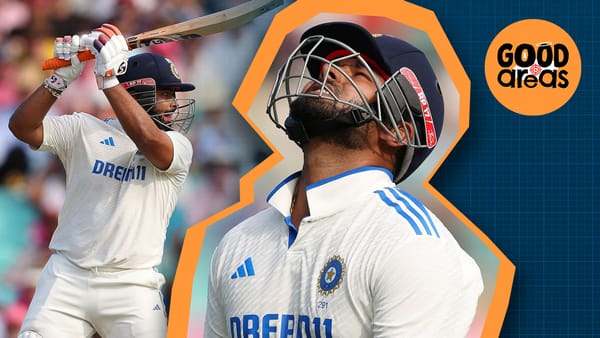The physical presence of Wahab Riaz
Taking a look at the big quick upon his International retirement.
If you have not heard this podcast, it is certainly worth your time.
With inputs from
Wahab Riaz steaming in was a physical presence. You felt him coming in; he was visceral. He was stamping towards the wicket, forcing his way there. It is all shoulders and spit. Every step was a thump; it looked like he was trying to battle the crease and hurl down one final missile to win it all.
I write a lot about stats, but Wahab was an experience.
And there is a good reason we don't talk about his figures. Compared to watching him come in, chest first, like a prize fighter trying to end it in the first round, his stats look like milk-stained toast.
For instance, he ended up with 83 wickets. And from 27 Tests. If you look at him compared to bowlers of his era, it's hard to see him as a plus Test bowler.

He was a fast bowler but he struggled in Australia. He could get the ball to swing, but it didn't work much in England or New Zealand. He was an Asian seamer, and it didn't work there either. There is not a place where he averaged better than 25, and only in Sri Lanka was it better than 30.

Yes, he is about moments. Yet in Tests, even that is hard to find. At the Oval in 2010, he took five wickets, and Pakistan won that Test.
That was also his first Test, so it was certainly some way to start. But it took him six years to finally add another to it.

That one was against the West Indies in the UAE. But the problem is they actually lost that game. And he never took another.
But I think Wahab was not about entire matches or even innings. Just sharp tiny moments that were unforgettable.
There was a four-wicket haul in Sri Lanka that got Pakistan back into a match they had no right to be in by rolling the hosts for 98. But they still lost that game, though he gave them a real chance.
There was also the mini-collapse against England in 2015 when he dismissed a set Joe Root followed by Ben Stokes and Jos Buttler. England never recovered in that match.
That was Wahab Riaz, a few minutes of chaos that could change a Test, but it very rarely happened.
What about ODIs? Well, really, it would be hard to say he had a great impact on ODI cricket. And yet, I feel this is how we all know him. But when you look at his numbers compared to bowlers in his era, it is hard to really see what he did well. He neither took wickets nor was economical. We think of him as this intense strike bowler, but really, he has a poor average, especially for someone who bowled as much at the death as he did.

But I did have this theory that something had affected him more than other bowlers. Instead of investing and fixing the white ball like a competent sport would, cricket just started paying for two balls per inning to overcome the white pill's uselessness. This happened in October of 2011. Wahab had played 22 matches at this point.

I expected a slight change; the difference is massive. He was half a run better when there was one ball and struck almost twice as often. With the old ball, he was one of the best bowlers in the world. It makes sense; he bowled with low arm action, so a soft ball was hard to hit away. His main skill was reverse, and with two balls, there was less of it.
From overs 30-50 in that original period, he had the third-best average in cricket. This is the Wahab that built the reputation as something to be feared.

But under two balls, he is just an also-ran as his average almost doubles. It is worth mentioning that Lasith Malinga, another low-arm bowler who loved reverse swing, has a similar problem in ODIs. The entire game became higher scoring, even though the fielding rules were different, but it affected Wahab and Malinga more. The game changed, and their actions were left behind a little.

When he started going for runs, he really went. Behram writes in his piece about how he almost became the first player to go for 100 runs twice in an ODI.
This got me thinking about how many times Wahab went at over eight runs an over for eight overs. (The crazy eight mark I made up). The answer is seven times. The only two bowlers of his era to do it more were Tim Southee and Malinga. The former played 50 more matches, and the latter was 90.

There is no way to look at this and think that he did well in ODIs. He just went for runs a lot.

Wahab barely played international T20s. His record isn't good either. And we also never saw him in the IPL. So he has an incredible T20 record, but it is from the lower levels. But the PSL is a proper league, and he has the second-best average ever.

But Wahab has been tested around the T20 map. Forget Bangladesh, where he does silly things. But in the CPL and Blast, he's a consistent threat, and really outside of his econ in the Lankan Premier League - where he was past his best -, he's been an incredible T20 player. But because it hasn't been in the IPL (which is not his fault, obviously, he certainly would have played if Pakistan players were still there) or an international career, it is hard to get an overall look at how good he is.

But even with that in mind, he has the second-best average of all T20 seamers with 5000 balls, and if you lop off 1000 balls, he's surrounded by some pretty good seam bowlers as well. So fit him in where you want.

In some ways, he was not built for T20s. One of the most Wahab Riaz moments ever is the ball to Steve Smith. The moment where he intentionally bowls a ball to miss the pitch on the offside, and Smith still flicks it to the legside.
Smith was standing outside off before the Wahab got into his leap. By the time the ball is released he almost steps off the wicket. Wahab has never seen the stumps this empty, yet he bowls one off the pitch. The whole thing is bizarre. But it's also very Wahab.
It is worth mentioning that he wasn't a nobody with the bat, but maybe most surprising is his ability to move around the field. He did not always have great skills, but he gave it his all.
There were also negatives, of course too; the jacket he was wearing back in 2010 was allegedly full of the cash. And for many, that was how he entered global cricket's thoughts.
But the reason this article exists is not stats, controversy or him throwing himself around the field. It's World Cup and moments.
Wahab went wicketless in the 2011 World Cup Quarter-Final; in the semi-final, he took Sehwag, Kohli and Dhoni. It was a lot of moments.
The big one is when he dismissed Yuvraj Singh first ball. That is not the right term. He demolished him. And on first look, this is a yorker. But it isn't. A yorker goes under the bat as you try to hit jam down. This is a full toss, but its pace and swing make it an atomic bomb that explodes the stumps.
But for all that, Pakistan lost.
This is the same man who has the second most wickets in ODI World Cup history for his country, behind only Wasim Akram. And ahead of Imran Khan, from way fewer matches. But let's be honest, for all those wickets, it's not even about the three tournaments he played in, but really one spell.

Pakistan had made only 213, and Australia's chase should have been easy.
Wahab starts to Michael Clarke, and he spoons it up in the air. But remember, Clarke could barely move by this stage in his career because of his back, which made him a target for the short ball.
Then in comes the big Queenslander, Shane Watson. I should point out that when I looked at Watson’s record in Tests and ODIs, I found no sign of him struggling with the short ball before this. Especially in ODI cricket.

And he's going to be facing Wahab Riaz, who's now fired up. He almost takes his head off. Then he runs past Watson and claps to his teammates to tell them something special is about to happen. It is the highest theatre. Shane Watson just looks confused.
Another short one almost destroys Watson again. This time, Wahab’s not trying to fire up his team; he wants Watto to know what is about to happen.
Wahab almost takes the front of his face off this time, and he claps at Watson again. By this point, it's pretty clear that Wahab is just on one. He's fast, he's furious, and his team doesn't have much of a chance if he doesn't go all in. This looks like the last spell of his life.
Unfortunately, as fast as he bowls, he can't get another breakthrough. Until Watson finally takes his eye off a hook, and the easy catch is completed at fine leg. Well, it should be. But Rahat Ali makes a mess of a simple chance.
Wahab is screaming. He takes that back out on Watson again, but despite almost taking his face off, a top edge flies almost to third, a fend almost ends at short leg and all the near misses. Eventually, after all of it, Wahab doesn’t take a second wicket, all he can do is laugh and blow Watson a kiss.
Australia will win this World Cup. Australia will win this game. And Watson will be there at the end.
Wahab was nothing but a spectacle.
But we're still talking about it. He was not the greatest bowler; he perhaps didn't even get the most out of himself, and all we have to hold onto are a few small moments. But with Wahab, when he got it right, there was almost nothing else you could think of.
When you think of great bowlers, you won’t think of Wahab, when you think of incredible moments, that physical presence steaming through the crease is vivid.




